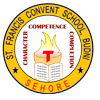Scholastic Area
The assessment structure and examination system is purely based on the latest scheme, norms and directives of CBSE i.e. Uniform System of Assessment which comprises of two terms i.e. Term-1 and 2 as explained below:

Affiliated to CBSE Delhi,No.1030879 | School Code:50843 | Dise Code:2330200135

St. Francis Convent School Budniendeavours its best for the development of an individual into a ‘Whole Person ‘who is aware of the world and its diverse culture, problems and people and who is skilled in his relations with his fellow men and his Creator hence the intellectual, Cultural and physical developments receive utmost care in this institution from the earlier stages.
The institution is known for its excellence in discipline, education and leadership. The importance of team spirit is inculcated with a concern to develop leadership qualities through academics, sports and games as well as other co-curricular activities.The main motto of the school curriculum is to inculcate the human values, faith in God, love for fellow beings and the academic excellence to transform their mind with a greater vision to see this world with a positive outlook and hence always be a channel of love and morally upright human being, so that they can be an asset to this world at large.The school is totally private un-aided and does not receive any grant-in-aid from any government. And the medium of instruction is English.
Affiliation: The school is affiliated to the Central Board of Secondary Education, New Delhi.
Course Content: -The Courses and Evaluation system used in our institution is purely based on the latest scheme, norms and directives of CBSE namely Uniform system of Assessment .Students too get familiar with the new pattern, rubrics and new schemes introduced by the Board. Examinations are conducted according to the Uniform System of Assessment and Examination. The whole academic session has altogether three Periodic Assessments, one Half Yearly (Mid Term) and Yearly (Final) Assessment used as a tool to monitor the student’s progress in the scholastic areas. Under this, the students will be tested internally in the form of pen paper based on Board Syllabus. Different methods and approaches are adopted for defining the educational outcomes of the students studying at various levels.
The assessment structure and examination system is purely based on the latest scheme, norms and directives of CBSE i.e. Uniform System of Assessment which comprises of two terms i.e. Term-1 and 2 as explained below:
Types of Assessment :
Mark distribution : total marks -100
Periodic Assessment – 10 marks
Grading Scale for Scholastic Areas
(Grades are awarded on an 8 Point Grade Scale as follows)
|
MARKS RANGE |
GRADE |
|
91-100 |
A1 |
|
81-90 |
A2 |
|
71-80 |
B1 |
|
61-70 |
B2 |
|
51-60 |
C1 |
|
41-50 |
C2 |
|
33-40 |
D |
|
32 & Below |
E (Needs improvement) |
For the holistic development of the student, co-curricular activities in the following areas will be carried out by the teachers and will be graded term-wise on a 3-point grading scale (A=Outstanding, B=Very Good and C=Fair).The aspect of regularity, sincere participation, output and teamwork be the generic criteria for grading in the following co-scholastic activities:
The students will also be assessed for the discipline which will be based on the factors like attendance, sincerity, behavior, values, and tidiness, respectfulness for rules and regulations, attitude towards society, nation and others. Grading on Discipline will be done term-wise on a 3-point grading scale (A=Outstanding, B=Very Good and C=Fair)